August 3, 2018
Air Date: August 3, 2018
FULL SHOW
SEGMENTS

Global Warming to Worsen Southern Poverty
View the page for this story
An interdisciplinary effort analyzed vast amounts of climate and economic data to forecast certain regions of the United States will be hit harder than others by global warming. Economist and lead author Solomon Hsiang of the University of California, Berkeley, told Living on Earth Host Steve Curwood the study estimates southern counties of the US, many of which are poor, could face a 20% decline in economic activity if carbon emissions continue unabated through the 21st century. (09:17)

BirdNote: When the Amazon Floods
/ Mary McCannView the page for this story
Floods can be devastating and destructive, but in the Amazon, as Mary McCann notes, annual floods are vital for many exotic bird species. (01:57)

Linking Fracking and Radon
/ Julie GrantView the page for this story
Pennsylvania homes have high levels of radon, a substantial risk factor for lung cancer. A recent research project from Johns Hopkins University surprised state experts when it found a correlation between the natural gas fracking boom and an increase in radon levels. But as the Allegheny Front’s Julie Grant reports, that may not be the whole story. (07:11)
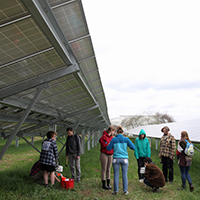
100% Sun Power for Hampshire College
View the page for this story
Hampshire College, with about 1400 students in Western Massachusetts, has just become the first residential U.S. College with 100% solar electricity. Hampshire College’s President, Jonathan Lash, joins host Steve Curwood to discuss the costs, benefits and ideas that underpin this switch to renewable energy. (06:47)

Fossil Fuel Freedom Fighters
View the page for this story
A new generation of nature writers is coming of age in America, and understanding how much of the pristine landscape their parents and grandparents enjoyed has gone. These new writers’ work is collected in the book Coming of Age at the End of Nature. Activist Bonnie Frye Hemphill reads and discusses part of her essay “Fossil Fuel Freedom Fighters”, and explains why, despite difficult odds, her generation is working towards a transition away from fossil fuels. (05:49)
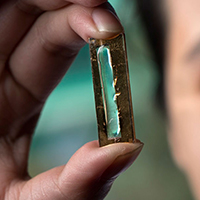
Science Note: Nanowire Battery Breakthrough
/ Alexander MetzgerView the page for this story
Even the best batteries can only be recharged so many times, but scientists have created a new nanowire based system that increases lifespan dramatically. As Alexander Metzger reports in today’s Note on Emerging Science, the key to this game-changing battery is a special coating. (01:43)
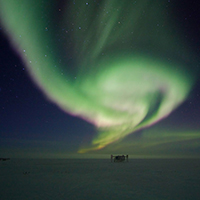
The Telescope in the Ice: The Hunt for the Ghost Particle
View the page for this story
One of the world’s most sensitive telescopes is buried deep in Antarctic ice, searching for evidence of elusive neutrinos, tiny, subatomic particles. Writer Mark Bowen’s new book, The Telescope in the Ice: Inventing a New Astronomy at the South Pole, chronicles the decades-long project to build the IceCube Neutrino Observatory. As he tells Living on Earth host Steve Curwood, IceCube’s ability to spot where neutrinos came from provides a powerful new tool for understanding many mysteries of the universe. (14:10)
Show Credits and Funders
Show Transcript
HOST: Steve Curwood
GUESTS: Mark Bowen, Solomon Hsiang, Jonathan Lash, Bonnie Frye Hemphill
REPORTERS: Julie Grant, Alexander Metzger, Mary McCann
[THEME]
CURWOOD: From PRI, this is an encore edition of Living on Earth.
[THEME]
CURWOOD: I'm Steve Curwood.
The millennial generation grapples with the new normal of a changing climate, and a planet in crisis.
HEMPHILL: I have no illusions that we’ll save the planet from the fossil fuel binge of recent centuries. The planet we evolved on is over. We're now locked into the crazy weather that’s on the news every night. But we can prevent collapse. We can protect our home enough to protect the human lives and livelihoods that depend on it.
CURWOOD: Also – the massive telescope in the ice – telling stories from 4 billion years ago.
BOWEN: If you’re standing on the South Pole, the instrument looks down. It is looking for neutrinos coming up from what would be the Northern sky, that have made it all the way through the Earth and then happened to interact with the ice right near the detector or even the bedrock below it.
CURWOOD: That and more this week on Living on Earth, stick around!
[NEWSBREAK MUSIC: Boards Of Canada “Zoetrope” from “In A Beautiful Place Out In The Country” (Warp Records 2000)]
[THEME]
Global Warming to Worsen Southern Poverty

Airman 1st Class Jeffrey Albright beating back the heat wave at Nellis Air Force Base in Nevada. (Photo: Master Sgt. Jason Edwards [Public domain], via Wikimedia Commons)
CURWOOD: From PRI and the Jennifer and Ted Stanley Studios at the University of Massachusetts Boston, this is an encore edition of Living on Earth. I’m Steve Curwood.
Global warming is on track to devastate the US economy in years ahead if temperatures are allowed to rise unabated, this according to a study published in the journal Science.
Economists based at the Climate Impact Lab in Berkeley, California project that the poorest third of counties in America would be most harmed, with incomes cut as much as 20 percent. The Lab is a consortium of experts from the Universities of California, Chicago, Rutgers, and the Rhodium Group, and this forecast used a wide variety of climate models and economic data. Economist Solomon Hsiang was one of the lead researchers. He teaches public policy at UC Berkeley and joins us now -- welcome to Living on Earth!
HSIANG: Thanks for having me.
CURWOOD: Now, which regions of the United States does your study predict will be hit hardest in this climate disruption scenario?
HSIANG: That’s actually one of the most interesting and surprising findings of this study. What we found is that the southern United States, southern parts of the Midwest, and also the Atlantic coast are some of the most hardest-hit parts of the country. There's a pretty good explanation for that once we did the analysis and we understood was going on. What happens is that the economic impact of warming is much worse if you are already pretty hot. So you can imagine going from 90 to 95 degrees is a much bigger deal going from 70 to 75 degrees, and so because the southern parts the country are already so warm a bit of warming does a lot more harm to them than to the northern parts of the country that tend to be cooler, and in some cases even, you know, the north can benefit. Places along the border with Canada are so cold that they’re actually, they have people who are getting sick from it being so cold, and this is an important finding because the northern parts the country tend to be wealthier today and the southern parts of the country tend to be poorer. So, by hurting the south more you're really hurting the poor population in the country relatively more, and this we think means inequality within the country could actually worsen.
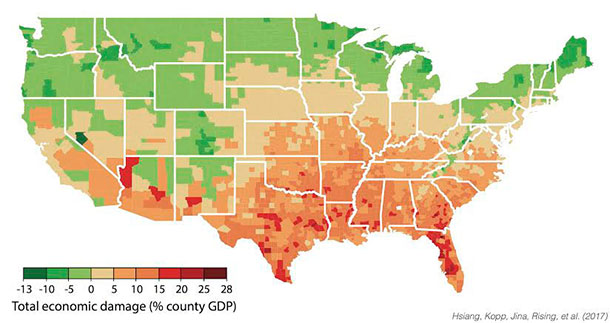
Climate Lab study prediction of economic damage by U.S. County. (Photo: Courtesy of Kathleen Maclay)
CURWOOD: Talk to me about that inequality. How much money are we talking about here?
HSIANG: Well, we're talking about places in the south that could possibly experience losses between 10 and 20 percent of their income in sort of a central case. Now, it's very hard to predict the future, so what we've done is we’ve actually thought about is actually a range of different scenarios that might occur, and so in some cases it gets actually much higher than that, and in some cases it gets lower, but the central case for the south - large swath of the south – to lose between 10 and 20 percent. And that's a lot, that’s actually be much worse than what was experienced during the Great Recession in the United States and it's not that different from what parts of the Midwest experienced during the dustbowl.
CURWOOD: Talk to me about those regions that you say will have modest benefits. It sounds like they are going to be making more money.
HSIANG: So, there are parts of the United States that could benefit from some warming, although those gains are more hazy in the data becomes they’re sort of mild benefits, but those are areas where you might save because you don't have to heat your house as much if things get a little bit warmer. So, those are places in the Rockies or along the northern border with Canada as well as New England. We looked at all different aspects of the economy and there's one place where the north actually gets hit worse than the south.
CURWOOD: Oh?
HSIANG: [LAUGHS] When you look at property crime. It turns out that the only way that the climate really affects property crime rates across the country is that when it's really cold and there's a lot of snow on the ground, nobody goes out and takes each other's stuff. No one steals a car if it's covered in snow. And so, right now, the north gets a lot of cold days and a lot of snow that protects it from this type of impact, but in the future, as things warm up it loses that protective cold, and so you actually see property crime rates rise in the north, but essentially nothing happens in the south.
CURWOOD: What about violent crime rates in your scenario?
HSIANG: So, we also studied violent crime, and violent crime responds to the environment very differently than property crime. We actually see that if you warm up populations - and this is actually true outside the US as well - we see violent crime rates go up very steadily pretty much for everyone. It doesn't matter what your initial temperature is. So, we see violent crime rates rise by about five percent across the entire country.
CURWOOD: So looking at some of the maps and charts that you have with your study, it looks like south Texas and Florida are really going to be in trouble in a warming scenario. How much trouble exactly for those places would you predict?
HSIANG: Those are the parts of the country where you could be seeing counties losing upwards of 20 percent of their income and that's due to the combination of what we talked about before, that those places are really hot and so getting hotter is extremely costly. But there's an additional issue that arises along the Gulf Coast which is the effects of sea level rise interacting with hurricanes, and so places like Texas, Louisiana and Florida end up having really large costs along their coastlines due to the fact that as the sea level rise goes up, the storms that arrive are going to have bigger surges, and in the future we expect to have a changing pattern of hurricanes where sometimes there will be more of them and sometimes they will be stronger, and so that can increase the economic losses you know, year over year for those reasons quite substantially.
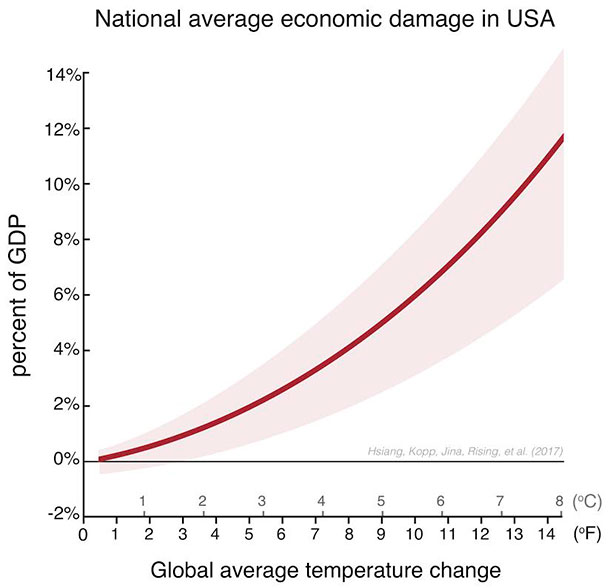
Climate Lab study forecast of national average economic damage in the U.S. (Photo: Courtesy of Kathleen Maclay)
CURWOOD: So, your research then is indicating in a general way as well as those specific places that the regions that are going to have the most economic damages from climate disruption are presently very politically conservative strongholds. To extent do you think your research might be able to, well, change the discussion with those lawmakers and their constituents?
HSIANG: Well, first just to be clear, all of our work was completely unrelated to the current political landscape. We've been working on this for many, many years. We didn't know these types of results until now, so the fact that people may not have taken these economic consequences into account in making their previous judgments about or in terms of how much they're concerned about climate change, maybe that's OK. Nobody knew that this was going to be what we saw in the data, but what we're hoping is that now the public can have a well-informed dialogue about how we want to manage the climate based on what we can see at least at this point about what might be lying ahead.
CURWOOD: So, how can you research be used to come up with, say, a more accurate social cost of carbon, a metric that can inform, perhaps, legislation, maybe carbon tax, other types of policies.
HSIANG: Yeah, and a lot of our work is exactly aiming at trying to inform the social cost of carbon. The social cost of carbon doesn't just reflect what people in Oklahoma or in California are going to feel. It also reflects the fact that when I drive my car here in California, the carbon dioxide goes up into the atmosphere, circles the planet over 80 times and is affecting people all over the world, and so we are undertaking a major effort to take what we've learned from this analysis and expand it to the whole world and then we'll be using those numbers to compute the social cost of carbon that could be used by regulators in any country really, not just the United States. This analysis, we show that the southern United States is the most heavily impacted because it’s hot relative to the north, but if you keep going south it just keeps getting hotter and hotter. So you think about Mexico, Central America, these places are going to experience these things we even more intense than the American south, and so it's really important that we understand what’s coming ahead for them and that we account for those losses to the global society.
CURWOOD: What about population increase? Here in United States we go from roughly 300 million people at the turn-of-the-century back there in the year 2000. By the middle of the century, it's projected we’ll be over 400 million people. The effects of climate disruption, reducing the economic prospects of folks in the south plus this population rise equals what, do you think?
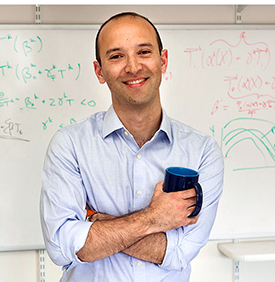
Solomon Hsiang is an Associate Professor of Public Policy at the University of California, Berkeley. (Photo: Courtesy of Kathleen Maclay)
HSIANG: Yeah, so one of the major challenges in economics generally as a field is just how do we maintain living standards and well-being for a population that's growing. It takes more resources to support more people moving ahead into the future and so what you try to do is maintain economic growth, which allows us to produce more material assets at least as fast as the population is growing, because if you just have more people in a place with a same number of material assets, then you have to start subdividing them more and more and more and everyone becomes a little poorer. What climate change does is it actually slows down the economic growth rate. It puts like a handicap on us in this race between economic growth and population growth, and so it makes it even harder for us. We have to be even more innovative. We need to work harder, and so what I think climate change is going to do is it’s going make it a lot harder to meet the standards of living that people expect, particularly in the regions that are hardest hit. So, people really dislike having long periods of unemployment or having long recessions, and one way I’ve put it to some folks is that climate change imposes something that's on the scale or sometimes bigger than a recession except it doesn't just go away, it’s not like we just recover from it. Once you have it, it's here to stay and so we think about whether or not we can make changes today that will avoid those types of outcomes and those are the types of questions we should be asking ourselves.
CURWOOD: Solomon Hsiang is an economist and Associate Professor of Public Policy of the University of California, Berkeley. Thank you so much Professor for taking the time today.
HSIANG: Thanks for having me.
Related links:
- The study in Science: “Estimating economic damage from climate change in the United States”
- Solomon Hsiang Faculty Profile
- The Climate Impact Lab
BirdNote: When the Amazon Floods

A Scarlet Macaw. (Photo: Tom Conger)
[MUSIC: BIRDNOTE® THEME]
CURWOOD: Floods can devastate the built environment. But as Mary McCann explains in today's BirdNote®, for the vast Amazon rain forest and its creatures, flooding is a different experience.
BIRDNOTE®/ WHEN THE AMAZON FLOODS
[Russet-backed Oropendola song http://macaulaylibrary.org/audio/60723, 0.13-.18]
MCCANN: To us humans, flooding can often seem like an unmitigated catastrophe. In the right circumstances, though, when it’s predictable and wildlife is well adapted, flooding can create a biological bonanza.
In the Amazon River Basin, annual heavy rains can raise water levels 30 to 40 feet in just days. The basin is almost flat, sloping just one inch per mile over its eastward flow to the Atlantic, a journey of some 2,000 miles. So, when the rain arrives, forests flood, and a massive push of sediment erects new islands almost overnight.
It’s a lush world that scientists and nature travelers explore by boat, where some of the world’s most iconic birds find fruit in the trees or perch at the water’s edge.
[Chestnut-fronted Macaw call, http://macaulaylibrary.org/audio/68380, 0.06-.08]
Toucans and macaws, tiny pygmy kingfishers, tiger-herons, and massive ringed kingfishers.

A Russet-backed Oropendola. (Photo: Tom Grey)
[Ringed Kingfisher call, http://macaulaylibrary.org/audio/211555, 0.10-.12]
Oropendolas sing a startling refrain.
[Russet-backed Oropendola song http://macaulaylibrary.org/audio/60723, 0.13-.18]
These birds are part of the richest array of life on earth, an extraordinary mosaic of habitats, all intricately linked. And all dependent on the river system that holds one-fifth of all the world’s fresh water.
I’m Mary McCann.
[Russet-backed Oropendola song http://macaulaylibrary.org/audio/60723, 0.13-.18]
###
Written by Bob Sundstrom
Bird sounds provided by The Macaulay Library of Natural Sounds at the Cornell Lab of Ornithology, Ithaca, New York. 60723 and 68380 recorded by Paul A Schwartz. 211555 recorded by Gregory F Budney.
BirdNote’s theme music was composed and played by Nancy Rumbel and John Kessler.
Producer: John Kessler
Executive Producer: Sallie Bodie
© 2016 Tune In to Nature.org October 2016 Narrator: Mary McCann
http://birdnote.org/show/seasonal-flooding-amazon
CURWOOD: Swoop on over to our website, loe dot org, for some pictures.
Related links:
- Russet-backed Oropendola’s song
- Chestnut-fronted Macaw call
- Ringed Kingfisher call
[MUSIC: Time For Three, “Ecuador,” Fervent Travelers, Ranaan Meyer/arr.Time For Three, Time For Three and E1 Music]
CURWOOD: Coming up, concerns about the radioactive gas radon and its links to fracking. That’s just ahead on Living on Earth, stay tuned.
ANNOUNCER: Support for Living on Earth comes from the Gordon and Betty Moore Foundation and from a friend of Sailors for the Sea, working with boaters to restore ocean health.
[MUSIC: Shall We Gather By The River, Arrangement by Lyndell Leatherman]
Linking Fracking and Radon
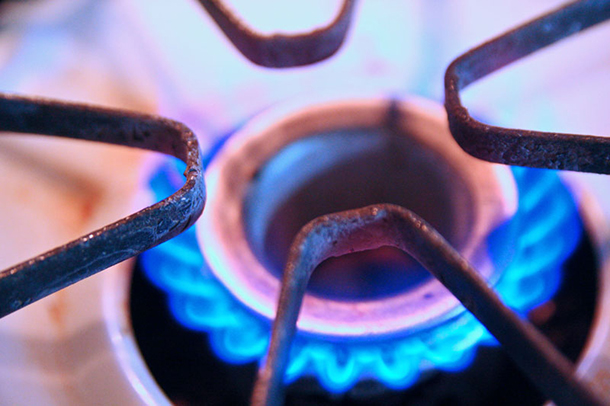
Research has linked fracking for natural gas to an uptick in radon in Pennsylvania homes, some of which exceed the actionable EPA limit 250 times over. (Photo: Steven Depolo, Flickr CC BY 2.0)
CURWOOD: It's Living on Earth, I'm Steve Curwood. You can’t see it, or smell it, but radon is the second biggest cause of lung cancer in the U.S, after smoking. This radioactive element is a gas at room temperature, and it can be locked in rock formations. And when wells are drilled for water or oil or natural gas, the drilling can release radon, which can then migrate into buildings. Today some of the highest radon levels can be found indoors in Pennsylvania and those levels are ticking up. As the Allegheny Front’s Julie Grant reports, some researchers are giving the gas a second look.
GRANT: Radon starts out as uranium, it’s naturally in soil and rocks. As the uranium decays, it becomes radon gas, and can seep into people’s basements. That’s common in Pennsylvania. So it’s no surprise there’s also radon in the Marcellus Shale, the rock formation that sits under much of the state.
CASMAN: The Marcellus is considered to be a fairly radioactive rock.
GRANT: Elizabeth Casman is a researcher in environmental engineering at Carnegie Mellon University. She’s seen the numbers: the Environmental Protection Agency estimates that indoor radon causes or contributes to 21,000 lung cancer deaths each year. So, after fracking in the Marcellus took off in Pennsylvania, its radioactivity kind of freaked Casman out…
CASMAN: The more I was reading about the formation, and the potential for radon in the natural gas, the more nervous I got.
GRNT: Concerned about lung cancer, she bought an electric kettle, and stopped cooking on the gas stove. More and more Marcellus gas is coming into our homes. And it’s bringing up a topic that many experts thought was settled. People like Dave Allard, who have known about radon in homes for a long time.
ALLARD: I’ve been around the block. [LAUGHS}
GRANT: He’s currently director of the Bureau of Radiation Protection at the Pennsylvania Department of Environmental Protection. Allard says the state already knows why Pennsylvania has high radon levels - it’s known since the mid 1980s.

A map of the locations where Carnegie Mellon University scientists collected radon samples. They color-coded each location to describe the calculated concentration of radon. (Photo: courtesy of Carnegie Mellon University)
ALLARD: We have some of the most unique geology, soils and rocks, creating probably some of the highest of radon levels naturally in the country, maybe the world…
GRANT: And he says radon in Pennsylvania is trending upward. They’ve seen some homes with levels 250-times the amount that’s actionable by the EPA.
ALLARD: And quite honestly some of our residential levels in Pennsylvania, are higher than you would allow in an occupational setting, or a uranium mine.
GRANT: So the DEP looked into it. Bob Lewis is the state’s chief radon officer. He tested at more than 30 wellheads in different regions of the state. At each site, he connected stainless steel cells into the gas well systems.
LEWIS: And then flow the natural gas through the cells for five to ten minutes, but then we do the analysis. And from that, we can then calculate the concentration of the radon in that natural gas at that particular wellhead.
GRANT: They did similar sampling at natural gas power plants, compressor stations and gas storage facilities.
LEWIS: We collected those samples in order to make some estimates of the end user.
GRANT: The end user, that’s us, cooking and heating our homes with natural gas. The DEP released his findings in early 2015.
LEWIS: And basically our conclusions, they show that they were receiving very small, radiation doses from the radon in natural gas.
GRANT: So, for the DEP, the issue was taken care of. Pennsylvanians are already advised to test for radon in their homes. And Marcellus Shale gas wasn’t adding to the problem. And then, the state’s radon experts got kind of blindsided.
LEWIS: Let me just give you… I’ve got their press, the Hopkins press release right in front of me…
GRANT: Using DEP’s own data, researchers at Johns Hopkins University published a study in Environmental Health Perspectives. The title? “Increased Levels of Radon in Pennsylvania Homes Correspond to Onset of Fracking.” Joan Casey was the lead author. She says her team noticed the upswing in radon happened around the same time as the fracking boom.
CASEY: And we wanted to see if this new industrial development potentially was contributing to increased levels of radon in homes.
GRANT: They broke up the state into different regions - places with no fracking, some fracking, and high levels of fracking.
When people test their homes for radon, the results are filed with the DEP. Casey’s team analysed 860,000 test results in the different regions.
CASEY: We saw at the same time that fracking was going on, increased levels of indoor radon in places that had the most fracking.
GRANT: They also looked more closely at a home or building’s proximity to fracking activity.
CASEY: And we found that buildings that were located closer to more drilled wells had significantly higher indoor radon concentrations than buildings located farther away.
GRANT: So needless to say, the DEP’s Dave Allard was pretty ticked by the media attention on this study. He thought Casey’s findings could unnecessarily scare people. One problem, Allard says, is that radon is trending up in every region of the state, no matter how close or far it is from fracking activity.
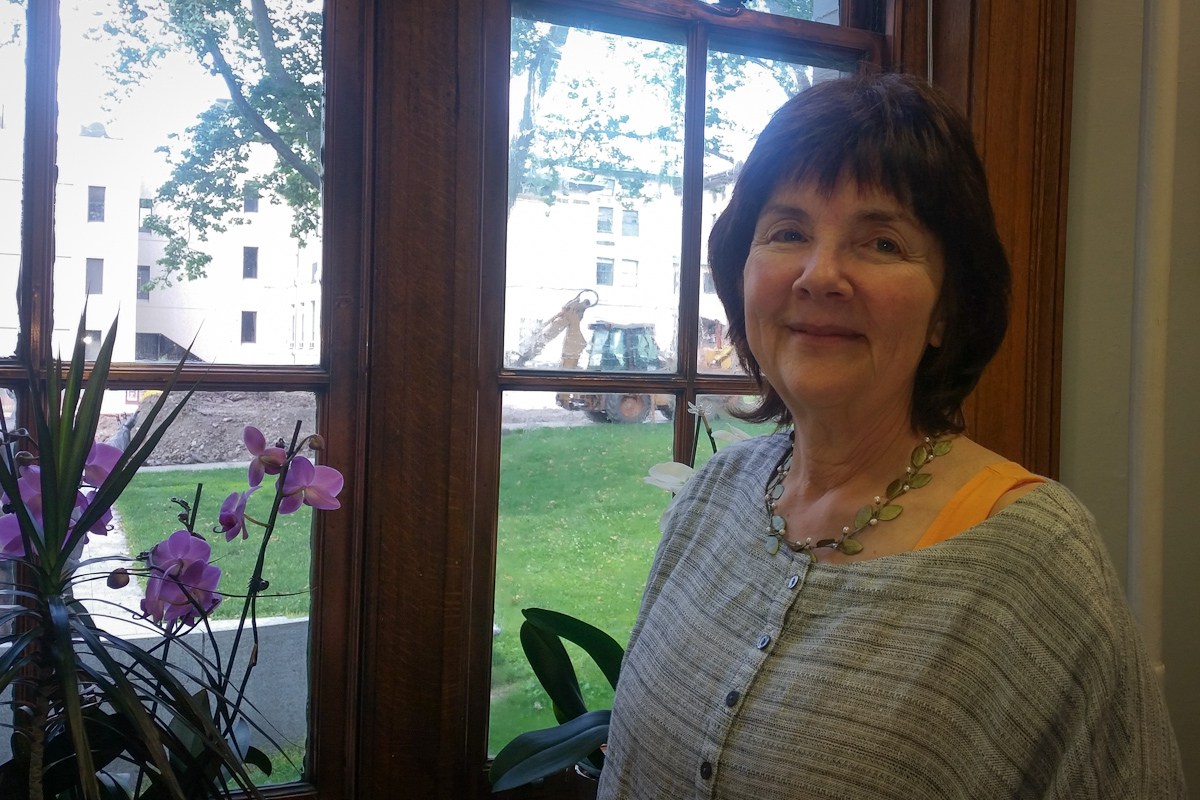
Elizabeth Casman took steps to minimize her potential exposure to radon when she learned about the radioactivity of the Marcellus Shale. (Photo: courtesy of Julie Grant))
ALLARD: Yea, there’s an uptick. But all of it is upticking through time.
GRANT: So he says there’s got to be a different cause. He’s convinced it’s related to increased soil moisture, and says that’s backed up by a study from Finland, published last year. Casey says her analysis takes rainfall into account. When she looks at her results, and those of the DEP study that found a small increase in indoor radon-- she says there’s reason for concern.
CASEY: There’s no safe level of radon exposure, in terms of lung cancer risk. And any increase in radon levels translates into an increased risk of lung cancer. That’s definitely true.
GRANT: Casey doesn’t really know why radon levels are increasing. She says maybe it could be entering homes through well water, ambient air, or the use of natural gas on the stove. Which brings us back to Elizabeth Casman. Remember her? She’s the CMU professor who stopped cooking because she was worried that radon in the gas would increase her risk for lung cancer. Like any researcher, she started gathering data. First, she and her team wanted to test right the kitchen burner. But that wasn’t easy.
CASMAN: It’s tricky.
GRANT: So, instead, with the agreement from energy companies, they took gas samples from pipelines. And Casman says she was relieved by the findings.
CASMAN: We took all the worst cases, and still it came out to a non-scary risk level. And that’s when I calmed down about cooking. I’m cooking again.
GRANT: Casman says unless someone used their unvented stove to heat their home, and they didn’t leave the house for 70 years, they wouldn’t really have an elevated risk of lung cancer from Marcellus Shale gas.
CASMAN: The increment from cooking from the Marcellus only is probably not going to be killing a lot of people.
GRANT: Still, Casman and others want more data. But for now, if you’re concerned about radon from your gas stove, she says, just open a window. I’m Julie Grant.
CURWOOD: Julie reports for the Pennsylvania public radio program, The Allegheny Front.
Related links:
- Johns Hopkins study linking increased radon levels to fracking
- EPA Radon Information
- Pennsylvania’s Radon Division
- The full Carnegie Mellon study
- Reporter Julie Grant’s Allegheny Front Bio
[MUSIC: King Sunny Ade, “Kita Kita Ko M’ola,” Afropop Stars Salute Africare, Afropop Worldwide/World Music Productions]
100% Sun Power for Hampshire College
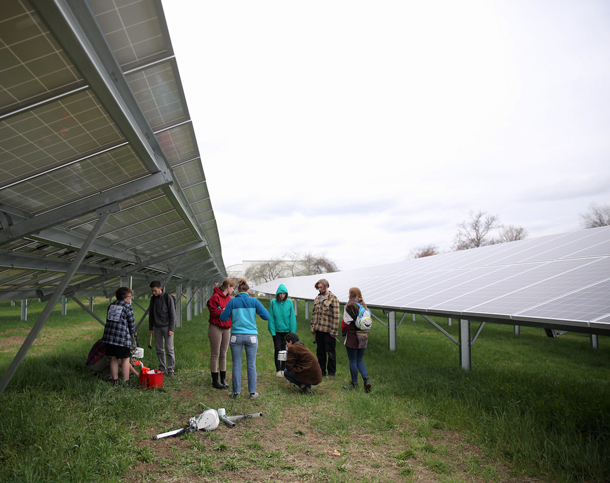
Hampshire College is the first residential U.S. college to go 100% solar for electricity. The 19-acre solar panel array was built on part of the campus’s open agricultural land. (Photo: Courtesy of Hampshire College)
CURWOOD: Colleges and universities are among the institutions leading the way on fighting global warming, and the first residential campus in the U.S. to go 100 percent renewable for its electricity was Hampshire College in Western Massachusetts. Hampshire was founded as a counter-culture school in the 1960’s with optional ‘do your own thing’ courses designed by students and a strong environmental focus. Indeed, the school mascot is a frog, atonement, legend has it, for wetlands drained for the first buildings. A few years ago Hampshire College recruited former World Resources Institute head Jonathan Lash to be its president, and his tenure has seen everything from net zero energy buildings to a 19-acre solar-power system. Jonathan Lash joins us now, welcome to Living on Earth!
LASH: Thank you. Glad to be here.
CURWOOD: Tell us, how is Hampshire College going 100 percent solar for electricity?
LASH: We installed 19 acres of solar collectors, about 15,000 panels, and those panels will produce 4.7 megawatts of power a year. That's more than the college uses. We’re hooked up to the grid, so in the dark of night, in the middle of winter, there is still power flowing to all our students' devices, but on a July day we'll produce a lot more power than we'll use, and that means on an annual basis we’ll produce more power than the school uses.
CURWOOD: Nineteen acres. Now, the cynics would say what about all those trees that had to die for the solar array?
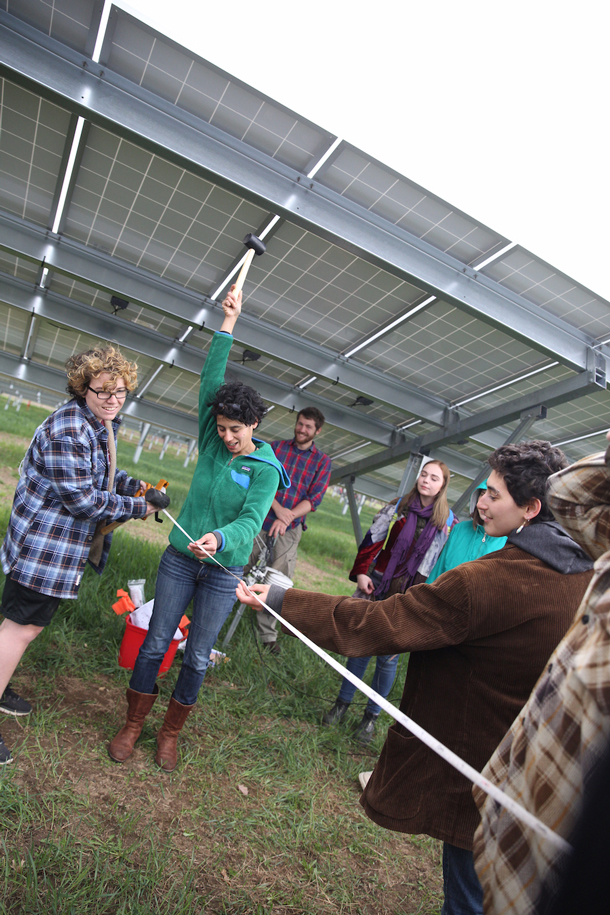
Students at Hampshire College conduct research around the newly-installed solar panel array. (Photo: Courtesy of Hampshire College)
LASH: That's a really interesting question actually, Steve. Our students were deeply involved in selecting the sites. We have an 800-plus acre campus, and a lot of it is agricultural land, fields that we mow for hay, use to grow vegetables, and we ended up choosing to use open ag land so we would not have to cut trees, and we have a group of students who have been doing research with one of their professors to determine whether, in fact, installing collectors has any long term, negative impact on that land.
CURWOOD: Hey, what do 19 acres of solar panels look like?
LASH: It's pretty hard to see them because they're set back on agricultural fields. They're not in your face. We had a committee of students, faculty, and staff who worked with our neighbors to assure we took their concerns into account, and one of the results is that the fields of panels are pretty well screened from the road, from nearby homes. It's a big expanse of large, reflective panels. If you look down on it from the air, it would attract your attention. If you look over at it from next door, you wouldn't see it.
CURWOOD: So, how does the solar energy system there at Hampshire College compare with what other colleges and universities are doing?
LASH: This is a great story that people don't know about. There are a lot of colleges and universities around the country who have decided to just get on with it. Some of their systems are bigger than ours. We're pretty proud that we decided to go 100 percent and that it's a little, not very well-resourced college out in snow country that's able to do this.
CURWOOD: So, let's talk about the economics of your switch. How much did it cost you upfront, and over the long term what do you think the economics will be?
LASH: We've contracted with SolarCity. SolarCity is paying to install the panels for us. We supplied the land, and we've signed a contract to buy all the power coming from the panels. We pay them a little over six cents a kilowatt hour. If we buy the electricity from the grid, we pay about thirteen and a half cents a kilowatt hour, so it's a big savings. And in the evening in winter, when our utility experiences peak demand, we pay over 30 cents a kilowatt hour, so the installer, Solar City, has supplied us with a bank of Tesla batteries that enable us to rely on the solar power stored in the batteries, rather than buy expensive power on an evening when everybody is using electricity. That's good for us and it's actually helpful for the utility.
CURWOOD: And you would pay that 30 cents to SolarCity or to the grid folks?
LASH: We pay that to the grid folks. If we buy power from them, we pay them. If we sell power to them, they pay us.
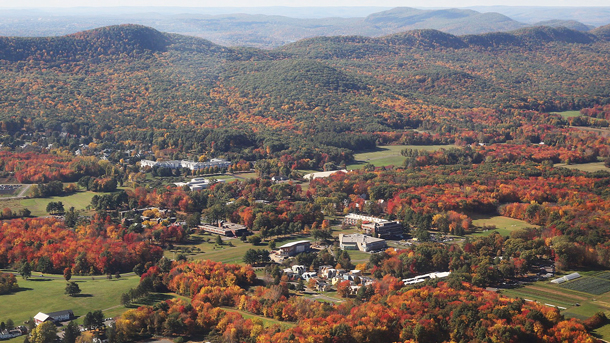
Hampshire College is part of a Five College Consortium in what’s known as the “Pioneer Valley” of Massachusetts, along with Amherst College, Smith College, Mount Holyoke College and the University of Massachusetts Amherst. (Photo: Courtesy of Hampshire College)
CURWOOD: We should mention by the way that SolarCity is an underwriter of Living on Earth. So what set this plan in motion?
LASH: Well, my background has been as an environmental advocate for the last 40 years, and when I got to Hampshire, the school was already thinking about how to become greener and had in place a commitment to reduce its greenhouse gas emissions. We took a look in 2012 at whether we could install solar, and it looked too expensive. Now, we looked again in 2015 and the price had come down so much, the efficiency of the panels had gone up so much, that we were able to move forward and have it be an overall savings rather than an expense for the college. We would do this just for economic reasons, but there are a lot of other reasons as well.
CURWOOD: How do you think the Hampshire College is going to benefit now from this switch?
LASH: The most important aspect of this for us is as part of the curriculum. Students were involved in every part of the decision, from the research that determined that, in fact, we were going to save money, to the choice of a contractor, to the selection of a site, working with neighbors, and now overseeing the management of the system. This is the challenge that our students and every other student is going to face in the next 20 years, how to turn the US economy into a low carbon economy, and they're going to get the real first-hand experience of doing it. So that was reason number one.

Before coming to Hampshire College, Jonathan Lash was president of the World Resources Institute, a Washington-based environmental think tank. (Photo: Courtesy of Hampshire College)
Reason number two is the economic benefit. We'll save $8 to $10 million dollars over the life of this system for Hampshire College. That's a big deal. It's really important.
Third reason is it's just the right thing to do in an era of accelerating climate change. This keeps the jobs local. It means that there are no pipelines being built through people's communities to get power to our college, and it helps, in the best way that we can, to avert climate change, the costs of which are falling most heavily on the poorest, most vulnerable people.
CURWOOD: So, Jonathan, hey, congratulations on putting all this together, using the sun.
Jonathan Lash is the president of Hampshire College. Thanks so much for taking the time with me today.
LASH: It was good to be with you.
Related links:
- Hampshire College
- Jonathan Lash, “Accepting The Challenge For Climate Action” in The Huffington Post
- Jonathan Lash Bio
[MUSIC: The Beatles, “Here Comes the Sun” on Abbey Road, composed by George Harrison, Apple Records]
Fossil Fuel Freedom Fighters

The fossil-free fight may be energized by youth, but Bonnie Frye Hemphill says there’s room for older generations in these movements as well. (Photo: John Silvercloud, Flickr CC BY-SA 2.0)
CURWOOD: College students of today are millennials, part of a generation that is “Coming of Age at the End of Nature.” That’s the title of an anthology of essays by young people, in which they grapple with the loss of wildness that Bill McKibben wrote about a generation ago, in his seminal book, “The End of Nature.” Virtually no place on Earth is completely untouched or unaffected by modern humans, and much of the millennial generation has no direct experience of wild, untamed nature. But the young authors of these essays give a fresh perspective on the loss of a wild Earth, and the new responsibilities we all share in protecting the nature that’s left. Today, we have another of these essays.
[MUSIC: Rockaby Baby! Lullaby Baby Trio, “Get Up, Stand Up” on Lullaby Renditions of Bob Marley, Bob Marley, Rockabye Baby Music]
HEMPHILL: My name is Bonnie Frye Hemphill. Here's an excerpt from my essay called, "Fossil Fuel Freedom Fighters."
Everything and nothing about the planet has changed in my lifetime. I am 27. Everything because I have never known a time when our home didn't have a man-made fever and nothing because we've done so little to stop stoking it. "Global warming is all we've ever known," Ben Lowe, a founder of Young Evangelicals for Climate Action explained to the Wall Street Journal. This conundrum makes McKibben's 1989 book, "The End of Nature" into Cassandra and a time capsule - prescient, ignored and almost buried. My grandmothers have told me stories of the World War II years, when Americans knew they had to work together and hard because justice was not a given.
My parent’s generation then fought for social and environmental action, but they thought they could fully succeed. Their sign said, "Save the Earth" because they thought they could. Like my grandmothers, we twenty-somethings don't assume climate justice will be done. We know that we must work for it, but unlike our parents, we who have come of age at the end of nature have grown past that naïveté about the planet's durability. We know that we cannot stop the climate from destabilizing.
My parents used to introduce me to their friends by offering with pride that I wanted to save the world. My gut clenched every time because I'm not that dumb. I have no illusions that we’ll save the planet from the fossil fuel binge of recent centuries. The planet we evolved on is over. We're now locked into the crazy weather that’s on the news every night. But we can prevent collapse. We can protect our home enough to protect the human lives and livelihoods that depend on it, and in seeking that salvation we might end up building something better than the status quo. After all, we're aiming for an economy powered by energy that doesn't blow up, innovations that require tons of new jobs, and a democracy disinfected from the desperate campaign donations of fossil fuel fat cats afraid of the future.
My generation is hopeful, practical, strategic and muscular, and not naïve. In fact, we are staking our very sense of self on it. We want history to write us as the ones who got to work. We are the fossil fuel freedom fighters and we’re on the move.
[MUSIC: Rockaby Baby! Lullaby Baby Trio, “Get Up, Stand Up” on Lullaby Renditions of Bob Marley, Bob Marley, Rockabye Baby Music]
I was in Doha, Quatar, right around the time I was writing this essay. It was for the UN climate conference there. One of the most meaningful parts of that visit was checking out the convention center where different groups could do displays on what they're doing to solve climate change, and several of the world’s largest oil producers had literally acres wide displays that were bleachy and gleaming and pastel colored and utterly deserted. The whole thing was such a farce.
[MUSIC: Rockaby Baby! Lullaby Baby Trio, “Get Up, Stand Up” on Lullaby Renditions of Bob Marley, Bob Marley, Rockabye Baby Music]
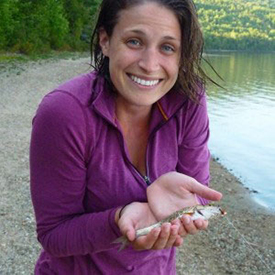
Bonnie Frye Hemphill is a solar designer and activist based in Seattle. Her essay “Fossil Fuel Freedom Fighters” is featured in the new collection Coming of Age at the End of Nature. (Photo: A&R Solar)
I kept coming back to a theme of honesty. Those who would deny climate change are desperate and delusional for building these massive displays on, you know, the climate action that BP is trying to take credit for. They're in denial. Anyone who’s got everything to lose should not be trusted, and so the sort of the derangement of climate denial comes off as so dishonest; whereas, by contrast, I think those of us who are fighting climate change we’re honest with the facts, the brutal facts of chemistry and physics that are warming our home, but also honest with ourselves that we cannot solve the whole problem anymore.
[MUSIC: Rockaby Baby! Lullaby Baby Trio, “Get Up, Stand Up” on Lullaby Renditions of Bob Marley, Bob Marley, Rockabye Baby Music]
Today's pollution has locked us in for 100 years of warming. I can't save the world from climate change, but I can help take the edge off it. There's a very big difference between rising seas that come up a couple of feet or come up 10 feet. The difference is Bangladesh, the difference is Florida.
[MUSIC: Rockaby Baby! Lullaby Baby Trio, “Get Up, Stand Up” on Lullaby Renditions of Bob Marley, Bob Marley, Rockabye Baby Music]
I've been working on this theme of freedom from fossil fuels for quite a while in my own mind. There's a common theme that those who would want to keep us on fossil fuels forever say, “Well, there's no other way. You drive a car so you must be disingenuous,” and I think that's answering the wrong question. I think the right question is not that I want to drive my car on gasoline. It's that I want to get from point A to point B. Offering freedom from fossil fuel only choices is what we're all about.
[MUSIC: Rockaby Baby! Lullaby Baby Trio, “Get Up, Stand Up” on Lullaby Renditions of Bob Marley, Bob Marley, Rockabye Baby Music]
There is real anger here. I think there's some stages of grief going on. I'm certainly not angry at those of previous generations who are doing their part for climate action, I'm angry at those who would prevent us, me, from solving their problem.
[MUSIC: Rockaby Baby! Lullaby Baby Trio, “Get Up, Stand Up” on Lullaby Renditions of Bob Marley, Bob Marley, Rockabye Baby Music]
CURWOOD: That’s writer Bonnie Frye Hemphill. Her essay is part of the collection, “Coming of Age at the End of Nature, A Generation Faces Living on a Changing Planet.”
[MUSIC: Rockaby Baby! Lullaby Baby Trio, “Get Up, Stand Up” on Lullaby Renditions of Bob Marley, Bob Marley, Rockabye Baby Music]
Related links:
- Listen to the first essay in this series: “Urban Foraging at the End of Nature”
- Listen to the second essay in this series: “High Tech Rain”
- Read the book, “Coming of Age at the End of Nature”
- About Bonnie Frye Hemphill
CURWOOD: Coming up, the search for the elusive “ghost particle,” the neutrino. That’s just ahead here on Living on Earth, stay tuned.
ANNOUNCER: Funding for Living on Earth comes from you our listeners and United Technologies, combining passion for science with engineering to create solutions designed for sustainability in aerospace, building industries, and food refrigeration. UTC companies such as Otis, Carrier, Pratt and Whitney, and UTC Aerospace systems are helping to move the world forward. You can learn more about United Technologies by tuning into the Race to Nine Billion podcast; listen at race to nine billion dot com. That’s race to nine billion dot com. This is PRI, Public Radio International.
[MUSIC: John Scofield, “Hit The Road Jack” on John Scofield Plays The Music of Ray Charles, 2005 Verve Music Group]
Science Note: Nanowire Battery Breakthrough
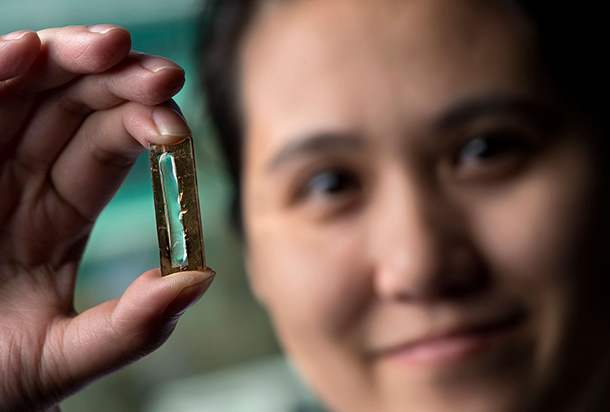
UC Irvine doctoral candidate Mya Le Thai displays her experimental nanowire technology that could dramatically increase the lifespan of rechargeable lithium-ion batteries. (Photo: Steve Zylius, University of California Irvine)
CURWOOD: It’s Living on Earth, I’m Steve Curwood. In a minute, searching the heavens for a tiny, subatomic particle. But first this note on emerging science from Alexander Metzger.
METZGER: From cell phones to laptops to cars, batteries power many of our everyday conveniences. As these devices become increasingly important, so does the lifespan of the batteries powering them. The popular lithium-ion battery, for example, survives only a few thousand charges at most. So researchers at the University of California, Irvine have developed a technology using nanowires that could increases battery life hundreds of times.
Because Nanowires are about a thousand times thinner than a human hair, bundling them together creates a huge surface area in a tiny volume. This translates to a greater capacity to store and conduct electricity than conventional wires. But there’s a snag: Nanowires quickly degrade when electricity passes through them, a problem that scientists have been working on for decades.
This breakthrough involves using gold nanowires coated in a manganese dioxide shell, and totally encased in an electrolyte gel. This makes wires flexible and resistant to cracking and enables hundreds of thousands of charging cycles with almost no damage to the wires themselves. While gold nanowires could become expensive if used in bulk, the researchers suggest that the same technique could work with cheaper, more common metals.
Scientists believe this technology could revolutionize how we power everything, from smart phones to spacecraft. While it may be many years before these next-generation batteries are on the market, this microscopic breakthrough has the potential to bring about some very big changes.
That’s this week’s note on emerging science, I’m Alexander Metzger.
Related links:
- Read the research paper: “100k Cycles and Beyond: Extraordinary Cycle Stability for MnO2 Nanowires Imparted by a Gel Electrolyte”
- University of California Irvine News: “All Powered Up”
- Los Angeles Times: “UCI researchers’ invention could lead to longer-lasting batteries”
[SCIENCE NOTE THEME]
The Telescope in the Ice: The Hunt for the Ghost Particle
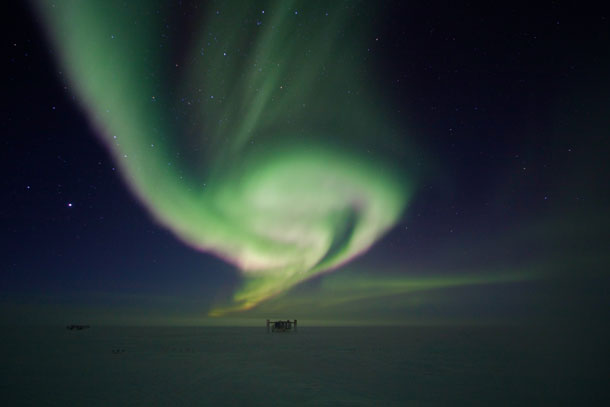
The aurora australis or Southern Lights produce different colors based on where electrons that enter our atmosphere encounter atoms of oxygen and nitrogen. Both the type of atom and the altitude affect the color that we see. Here a colorful aurora swirls above the IceCube Lab. (Photo: Keith Vanderlinde, NSF)
CURWOOD: Ever since Galileo turned his telescope towards the heavens four centuries ago, these finely tuned instruments have produced breathtaking images – of planets, and other galaxies. And now one of the most exciting new telescopes has helped solve a 100-year mystery. Until now no one knew where neutrinos came from.
These tiny, almost massless subatomic particles can pass through a light-year of lead without slowing down, and scientists think they can help explain the origins of the universe. And now after years of observations scientists have finally tied a captured neutrino to a specific, massive galaxy. It’s a black hole, some 4 billion light years away called a blazar. The IceCube Neutrino Observatory is the telescope that can detect neutrinos and it’s very creation is an epic tale that writer Mark Bowen captures in his book, “The Telescope in the Ice.” Mark Bowen joins us now, welcome to Living on Earth!
BOWEN: Well, thanks for having me Steve.
CURWOOD: So, IceCube is designed to detect neutrinos, sometimes called ghost particles. So, in layman's terms, what exactly is a neutrino?
BOWEN: It is an elementary particle, that means I don't think it can be broken up into anything else. It's a very basic constituent of matter and it's really odd and very hard to detect. It was, interestingly, one of the first elementary particles to be discovered. The only ones that were known in 1930 when Wolfgang Pauli had this incredible feat of kind of insight and intuition were the proton, the photon, and the electron. And the strange thing about the neutrino is that even now nobody understands it very well, and it's one of the forefronts of particle physics because it just is this really weird particle.
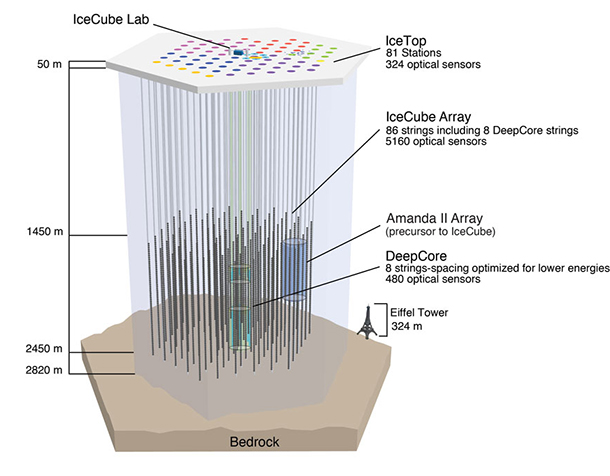
The IceCube Neutrino Observatory instruments a volume of roughly one cubic kilometer of clear Antarctic ice with 5,160 digital optical modules (DOMs) at depths between 1450 and 2450 meters. The observatory includes a densely instrumented subdetector, DeepCore, and a surface air shower array, IceTop. (Image: IceCube Collaboration)
CURWOOD: Why is science so fascinated with the neutrino? What is it that we're trying to understand, do you think?
BOWEN: For two reasons, first of all, it will help explore the universe, explain the behavior of these incredibly strange things that are being discovered far off in outer space. We have now entered this era called multi-messenger astronomy. We saw this merging neutron star event which resulted in a gravitational wave, and it was also seen with light. The neutrino would be yet a third messenger besides light and gravitational waves with which we can look at these exotic things like merging neutron stars or blazars, these incredibly bright galaxies off in the cosmos and things of that sort.
So, it's an astrophysical tool, and the neutrino has so far revealed the only physics beyond the standard model of particle physics. So, back in the 1970s, people like Steven Weinberg, Sheldon Glashow, Abdus Salam, put together something called the standard model which explains by now all the known elementary particles. The last one that was discovered was the Higgs boson to great fanfare in 2012. Well, it's getting a little bit scary now because the standard model works so well that it's beginning to feel like a straitjacket. It seems like people have discovered everything that they-- that they can discover and scientists don't like that. They like to discover new things, but the neutrino has actually revealed some physics beyond the standard model. The standard model says that it should not weigh anything and an experiment very much like IceCube showed in 1997 that neutrinos have mass. So, right now there are probably a billion or more dollars worth of research efforts aimed at trying to explore the neutrino to see if they can uncover new physics that might lead to, oh, just new beauty in the universe really. I mean, basic science is exploration at its heart.
CURWOOD: Talk to me about the basic design of the IceCube and how on Earth it's supposed to be able to detect these tiny particles that are...they have mass, but barely apparently.
BOWEN: The key to detecting one at least in this case is to monitor some huge volume of some clear material and watch for an interaction of the neutrino...a neutrino with that material. What happens is, when a neutrino interacts with either a proton or a neutron, something in the nucleus of any atom at all, or molecule, it disappears and knocks out a particle that gives off light that can be seen. So, you don't actually look at the neutrino itself, you look at the product of the neutrino’s demise and that particle is knocked out just like -- as if you hit a billiard ball head on with a cue ball, gets knocked out of that nucleus going in pretty much exactly the same direction as the neutrino was going in.
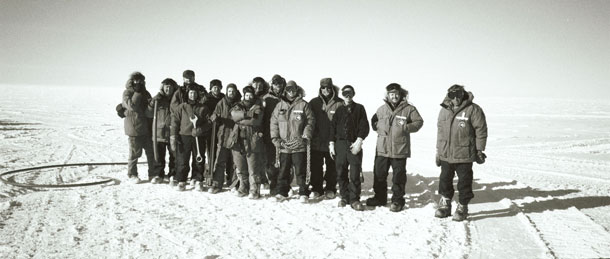
Members of the AMANDA (Antarctic Muon And Neutrino Detector Array) drilling crew in the millennial season of 1999-2000. “Master driller” Bruce Koci stands at the far right. (Photo: Mark Bowen, AMANDA/NSF)
A neutrino can produce three kinds of particles, but the basic one, the workhorse is called a muon, which is just like an electron, but it happens to weigh more and it has some other slight differences. The muon will speed through the ice or you can use water or you can use air. It has to be clear because you have to see the light that it's giving off. It's actually going faster than light can travel in that medium. It's not breaking Einstein's postulate of special relativity that nothing can travel faster than the speed of light. It’s travelling about the speed of light but light itself would go slower because that medium has an index of refraction. So, therefore, what happens is it drags a cone of light behind it because the light can't keep up with it. It's just like a boat on a lake. The reason that the waves come off at an angle behind the boat is that the waves can't go as fast as the boat, and that's exactly what's happening except it's three dimensional.
So, this thing is zooming through the ice and it's dragging this cone of -- of light behind it, and what the IceCube scientists have done is drilled deep, deep holes, a mile and a half, or a mile and three-quarters deep in the incredibly clear ice at the South Pole, and dropped into them these strings of pearls, these basketball sized light detectors, and they've created this three dimensional grid of light detectors in the ice. And since that muon is traveling in the same direction as the neutrino was, you have a telescope, you can see where that neutrino came from, you can point back and see what object might have created that neutrino.
CURWOOD: So, Mark, if you just need a clear medium, why not use water? Why not use air? Why go to the South Pole and drill a mile and a half in the ice and, you know, that's not exactly the easiest place to work, the South Pole.
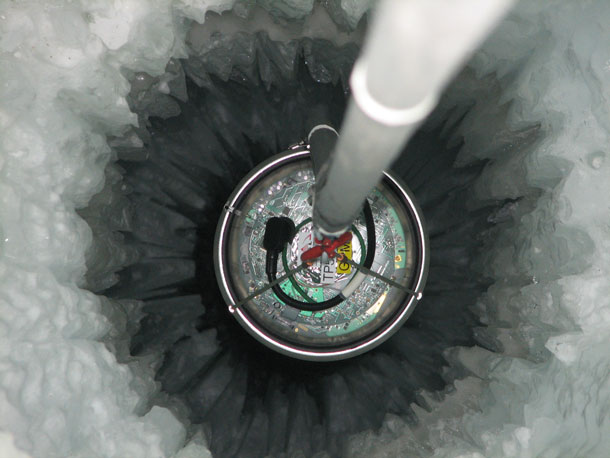
The deployment of each of the 86 IceCube strings lasted about 11 hours. In each one, 60 sensors (called Digital Optical Modules, or DOMs) had to be quickly installed before the ice completely froze around them. (Photo: IceCube/NSF)
BOWEN: Yes, very good question. As it turns out, amazingly, the South Pole is a very easy place to work compared to the ocean because you don't have waves, because you can walk on your experiment, because you don't have to deal with ocean engineering, and in fact, the first valiant and pioneering attempt to do this was off the coast of the big island of Hawaii. They tried for something like 14 years and failed because, largely, of the difficulties of deploying these same sorts of strings of detectors on the ocean floor, and so it turns out to be cheaper, they tried this project in Hawaii, they had been going for something like 10 years or 11 years by the time the project that is now IceCube, it was then known as AMANDA, the Antarctic Muon and Neutrino Detector Array. They began trying to deploy strings in the ice in 1991, and they actually succeeded in having a semi-working instrument by 1993, in like two or three years, whereas the Hawaiian project, even after 11 years, hadn’t deployed a string on the bottom of the ocean.
CURWOOD: And tell me why the atmosphere isn't a great place to try to detect these neutrinos from outer space?
BOWEN: So, both IceCube and this Hawaiian attempt which was called DUMONT, the Deep Underwater Muon and Neutrino Detector are buried like a mile deep in the water or the ice. The reason is that you use that overburden, what's above the instruments as a shield because right now, Steve, you and I have zillions of cosmic ray particles zipping through our bodies and into the Earth. IceCube is buried more than a mile deep in the ice in order to block or attempt to block those particles. Some of them still punch through all the way down, a mile deep. So, the instrument is actually designed to look the other way. If you're standing on the South Pole, the instrument looks down. It's looking for muons coming up from what would be the northern sky. It is looking for neutrinos that have made it all the way through the Earth and then happen to interact with the ice right near the detector or even the bedrock below it, and set a muon zooming through the detector.
CURWOOD: So, IceCube and its predecessor AMANDA, that Antarctic Muon and Neutrino Detector Array that you described, required actually drilling holes hundreds and well, thousands of meters deep into Antarctica's ice. How on Earth did the master driller, and his name is Bruce Koci, and his team accomplish this in such a hostile environment?
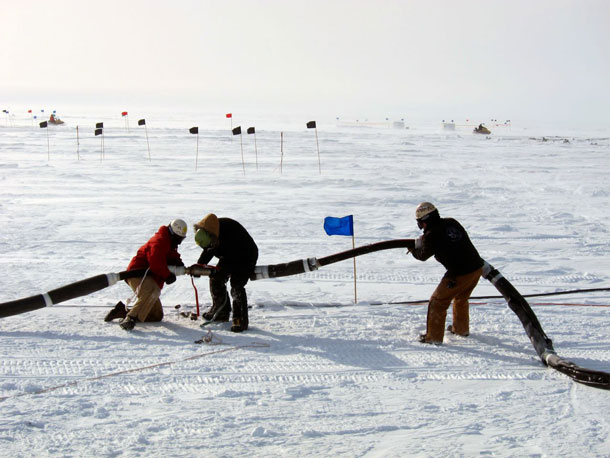
Members of the drilling crew working on the hose that carried hot water across the ice from the heating plant to the IceCube drill. (Photo: IceCube/NSF)
BOWEN: Bruce was capable of dealing with hostile environments. [LAUGHS] I tell the story about when they first met him because they did a test hole in Greenland back in 1990 or something like that, Bruce would sleep outside in an unheated tent on the summit of Greenland 10,000 feet high. You had this kind of intuitive almost shamanistic knowledge of ice that Bruce Koci had from decades of drilling ice cores and doing hot water drilling which is what IceCube uses, and basically they just stuck their nose into it, made a bunch of mistakes and learned as they went along. They also had to deal with whether they had enough funding and enough support, so sometimes they had to compromise on the drill just because they couldn't get enough money to build the one they really wanted to build, and you know the first drill they tried actually got stuck in the ice. So, then they go back two years later and they have a successful drilling season, and then they slowly work themselves down deeper and deeper into the ice and the first time they got really deep into the ice I think it took 12,000 gallons of fuel and it probably took them five days or a week to drill the hole, and by the time they were drilling the 86 holes they needed to drill for IceCube, I think they could drill a hole in something like 24 hours and they used only something like 3,000 gallons worth of fuel. So, over time you just learn and you just hone it and it's a real team effort.
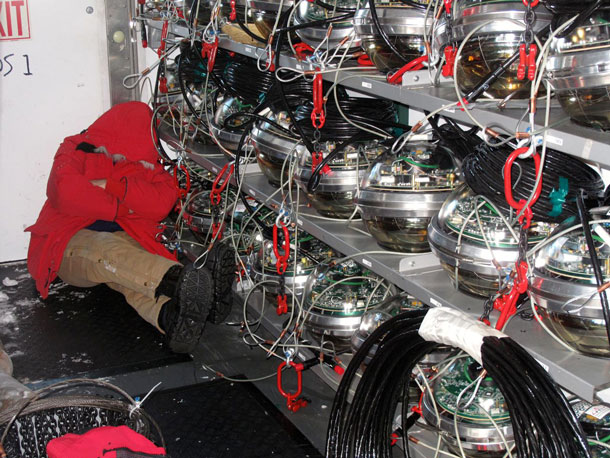
An exhausted IceCubist catches a nap in the drilling and deployment building, next to a rack of IceCube DOMs ready to be dropped into the ice. (Photo: IceCube/NSF)
CURWOOD: Talk to me about the moment that somebody actually saw one of these neutrinos from outer space, not locally produced by cosmic rays dancing around in our atmosphere. Talk to me about that moment and what that was like.
BOWEN: That was a very interesting moment. First of all, I think it happened in 2011. So, they had been working on this for 14 years at that point since it began in 1987, the experiment. And it was a Japanese woman by the name of Aya Ishihara at the University of Chiba in Japan. She had been working on IceCube for a long time, several years. So, she was looking for a very high energy kind of neutrino that comes from very high energy cosmic rays bouncing off the cosmic microwave background. They are thousands of times more energetic than any particle that could be created at the Large Hadron Collider. Of course, she was looking down into the earth. She was looking at the northern sky.
What happened was two incredibly high energy neutrinos snuck past the filters she was using to find the particles she was looking for, and they came from the southern sky. So, it was a total surprise. It was a mistake. Her filters weren't good enough, and when they looked closely at those two neutrinos, they realized that they had to be coming from outer space. They named them Bert and Ernie after the two Muppet characters.
[CURWOOD LAUGHS]
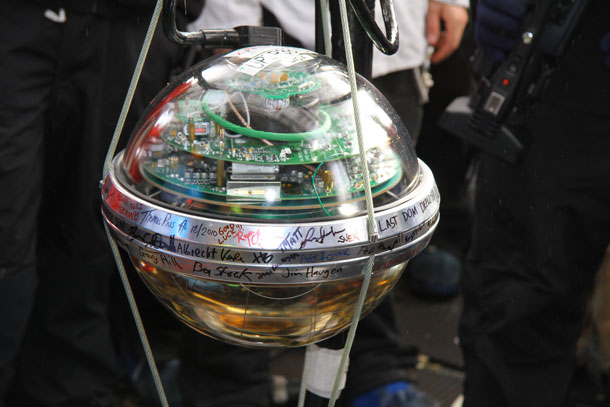
Scientists, engineers and drillers working on the deployment of IceCube in December 2010, signed the last DOM before it was buried one mile deep in the Antarctic ice. (Photo: Robert Schwarz, NSF)
It was a graduate student in Wisconsin who did that because you know they had some absurdly long number attached to them because each event has a number attached to it, and they just studied those things up the wazoo. You know, you had 200 physicists going crazy about what these things were. So, as with so many great things in science and in physics, they had been working for 14 years looking at the northern sky, and the first neutrinos that they detected from outer space snuck in from behind their telescope and came from the southern sky. And so then they totally reoriented themselves and started looking at these things and they've since found dozens and dozens more. And that was really the experiment that showed that they now can detect unequivocally neutrinos coming not from our atmosphere, which is kind of like the background light created by cities, makes it hard to see stars, we have the same problem with neutrinos, but from the cosmos somewhere. And Aya says, you know, it was like the greatest experience of her life, this is what physicists and scientists live for, discovering new things looking at how the universe works, brings us out of ourselves and makes our minds bigger somehow. The thrill of the chase and then suddenly having the surprise which just blows your mind.
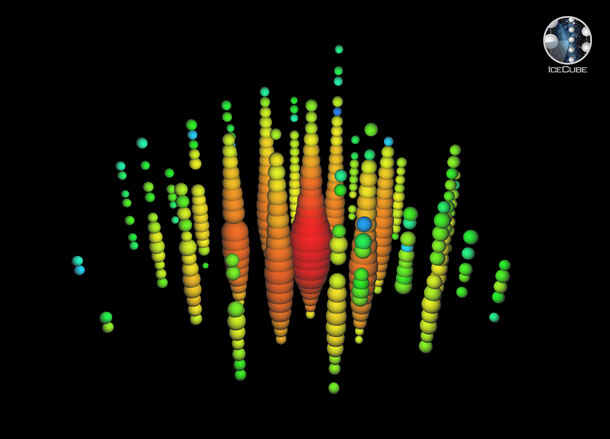
“Ernie”, the highest-energy neutrino observed to date, explodes inside IceCube. Since the entire detector is about a kilometer on a side, “Ernie” would have more than filled a professional football stadium. (Image: IceCube Collaboration)
CURWOOD: Mark Bowen’s PhD is in physics, but he's now a writer and his book is called, "The Telescope in the Ice: Inventing a New Astronomy at the South Pole." Mark, thanks so much for taking the time with us today.
BOWEN: Thank you, Steve, it's been a pleasure.
Related links:
- The Telescope in the Ice: Inventing a New Astronomy at the South Pole
- Scientific American: "Neutrinos on Ice: Astronomers' Long Hunt for Extragalactic 'Ghost Particles' Pays Off"
- IceCube Neutrino Observatory
- Mark Bowen’s blog “Tipping Points: Science and Writing in a Changing World”
- WATCH: “What is a Neutrino?” by MinutePhysics
[MUSIC: Thelonius Monk, “Ask Me Now” on Genius Of Modern Music, Vol. Two, Blue Note]
CURWOOD: Living on Earth is produced by the World Media Foundation. Our crew includes Naomi Arenberg, Bobby Bascomb, Thurston Briscoe, Savannah Christiansen, Jenni Doering, Anna Gibbs, Don Lyman, Maggie O’Brien, Aynsley O’Neill, Sarah Rappaport, Jake Rego, Adelaide Chen, and Jolanda Omari. Tom Tiger engineered our show. Alison Lirish Dean composed our themes. You can hear us anytime at L-O-E dot org - and like us, please, on our Facebook page - PRI’s Living on Earth. And we tweet from @livingonearth. I’m Steve Curwood.
Thanks for listening!
ANNOUNCER: Funding for Living on Earth comes from you our listeners and from the University of Massachusetts, Boston in association with its School for the Environment, developing the next generation of environmental leaders. And from the Grantham Foundation for the Protection of the Environment, supporting strategic communications and collaboration in solving the world’s most pressing environmental problems. Support also comes from the Energy Foundation, serving the public interest by helping to build a strong clean energy economy.
ANNOUNCER 2: PRI, Public Radio International.
Living on Earth wants to hear from you!
Living on Earth
62 Calef Highway, Suite 212
Lee, NH 03861
Telephone: 617-287-4121
E-mail: comments@loe.org
Newsletter [Click here]
Donate to Living on Earth!
Living on Earth is an independent media program and relies entirely on contributions from listeners and institutions supporting public service. Please donate now to preserve an independent environmental voice.
NewsletterLiving on Earth offers a weekly delivery of the show's rundown to your mailbox. Sign up for our newsletter today!
 Sailors For The Sea: Be the change you want to sea.
Sailors For The Sea: Be the change you want to sea.
 The Grantham Foundation for the Protection of the Environment: Committed to protecting and improving the health of the global environment.
The Grantham Foundation for the Protection of the Environment: Committed to protecting and improving the health of the global environment.
 Contribute to Living on Earth and receive, as our gift to you, an archival print of one of Mark Seth Lender's extraordinary wildlife photographs. Follow the link to see Mark's current collection of photographs.
Contribute to Living on Earth and receive, as our gift to you, an archival print of one of Mark Seth Lender's extraordinary wildlife photographs. Follow the link to see Mark's current collection of photographs.
 Buy a signed copy of Mark Seth Lender's book Smeagull the Seagull & support Living on Earth
Buy a signed copy of Mark Seth Lender's book Smeagull the Seagull & support Living on Earth

